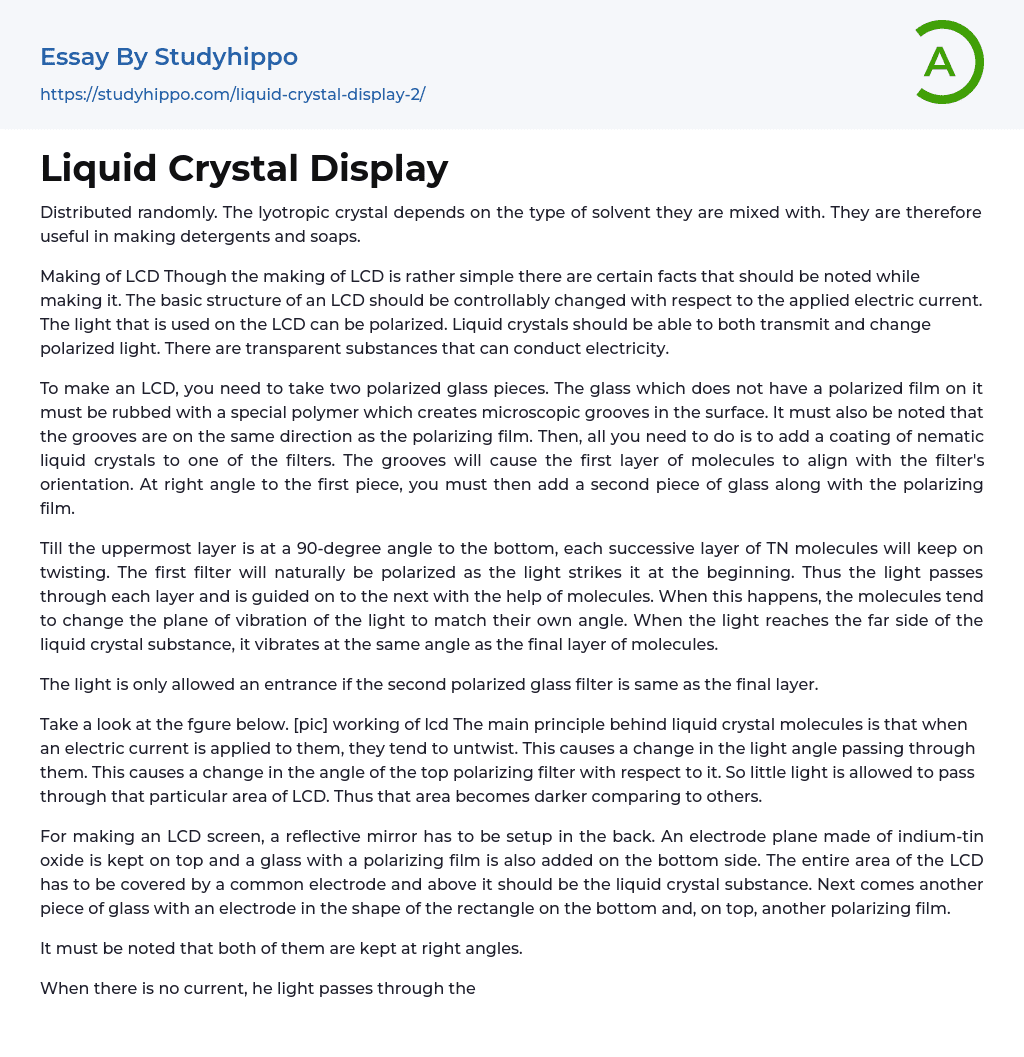Distributed randomly. The lyotropic crystal depends on the type of solvent they are mixed with. They are therefore useful in making detergents and soaps.
Making of LCD Though the making of LCD is rather simple there are certain facts that should be noted while making it. The basic structure of an LCD should be controllably changed with respect to the applied electric current. The light that is used on the LCD can be polarized. Liquid crystals should be able to both transmit and change polarized light. There are transparent substances that can conduct electricity.
To make an LCD, you need to take two polarized glass pieces. The glass which does not have a polarized film on it must be rubbed with a special polymer which creates microscopic grooves i
...n the surface. It must also be noted that the grooves are on the same direction as the polarizing film. Then, all you need to do is to add a coating of nematic liquid crystals to one of the filters. The grooves will cause the first layer of molecules to align with the filter's orientation. At right angle to the first piece, you must then add a second piece of glass along with the polarizing film.
Till the uppermost layer is at a 90-degree angle to the bottom, each successive layer of TN molecules will keep on twisting. The first filter will naturally be polarized as the light strikes it at the beginning. Thus the light passes through each layer and is guided on to the next with the help of molecules. When this happens, the molecules tend to change the plane of vibration of th
light to match their own angle. When the light reaches the far side of the liquid crystal substance, it vibrates at the same angle as the final layer of molecules.
The light is only allowed an entrance if the second polarized glass filter is same as the final layer.
Take a look at the fgure below. [pic] working of lcd The main principle behind liquid crystal molecules is that when an electric current is applied to them, they tend to untwist. This causes a change in the light angle passing through them. This causes a change in the angle of the top polarizing filter with respect to it. So little light is allowed to pass through that particular area of LCD. Thus that area becomes darker comparing to others.
For making an LCD screen, a reflective mirror has to be setup in the back. An electrode plane made of indium-tin oxide is kept on top and a glass with a polarizing film is also added on the bottom side. The entire area of the LCD has to be covered by a common electrode and above it should be the liquid crystal substance. Next comes another piece of glass with an electrode in the shape of the rectangle on the bottom and, on top, another polarizing film.
It must be noted that both of them are kept at right angles.
When there is no current, he light passes through the front of the LCD it will be reflected by the mirror and bounced back. As the electrode is connected to a temporary battery the current from it will cause the liquid crystals between the common-plane electrode
and the electrode shaped like a rectangle to untwist. Thus the light is blocked from passing through.
Thus that particular rectangular area appears blank. Colour Liquid Crystal Display Colour LCDs are those that can display pictures in colours. For this to be possible there must be three sub-pixels with red, green and blue colour filters to create each olour pixel.
For combining these sub-pixels these LCDs should be connected to a large number of transistors.
If any problem occurs to these transistors, it will cause a bad pixel. One of the main disadvantages of these types of LCDs is the size. Most manufacturers try to reduce the height than gain it. This is because more transistors and greater pixels will be needed to increase the length. This will increase the probability of bad pixels.
It is very difficult or also impossible to repair a LCD with bad pixels. This will highly affect the sale of LCDs.
- Organic Chemistry essays
- Acid essays
- Calcium essays
- Chemical Bond essays
- Chemical Reaction essays
- Chromatography essays
- Ethanol essays
- Hydrogen essays
- Periodic Table essays
- Titration essays
- Chemical reactions essays
- Osmosis essays
- Carbohydrate essays
- Carbon essays
- Ph essays
- Diffusion essays
- Copper essays
- Salt essays
- Concentration essays
- Sodium essays
- Distillation essays
- Amylase essays
- Magnesium essays
- Acid Rain essays
- Wall Street essays
- Dead Poets Society essays
- A beautiful mind essays
- Sherlock Holmes essays
- Our day out essays
- American Beauty essays
- Do The Right Thing essays
- Forrest Gump essays
- Good Will Hunting essays
- Finding Forrester essays
- Looking For Alibrandi essays
- On The Waterfront essays
- One Flew Over The Cuckoo'S Nest essays
- Rabbit Proof Fence essays
- Remember The Titans essays
- Schindler'S List essays
- Shawshank Redemption essays
- The Blind Side essays
- Titanic essays
- Witness essays
- The Veil essays
- Blade Runner essays
- Monster essays
- The Graduate essays
- Twilight essays
- West Side Story essays




